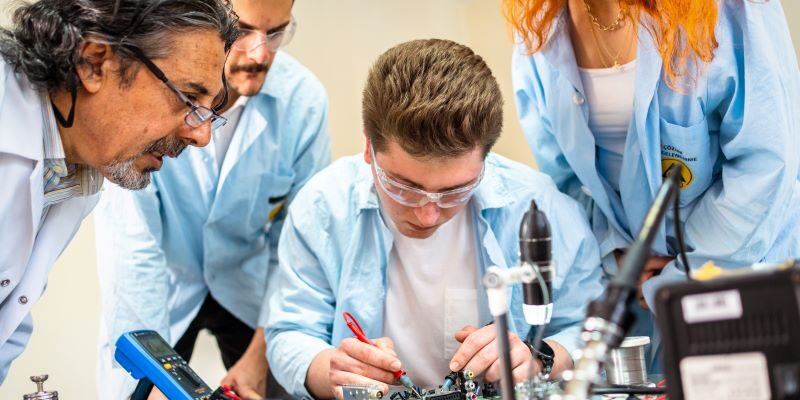| By Gale Staff |
Recent survey data reveals that nearly 72% of graduates feel unprepared for life after high school. Challenges range from a lack of career exploration to inadequate real-world experience, leading students to struggle with planning their futures, from choosing a college major to starting a career.1
The disconnect between academic achievement and career readiness is a growing concern for educators, employers, and families alike. So, what’s preventing students from feeling equipped for the realities of today’s college and workforce environment, and how can your district provide more support to bridge the gap between graduation and future readiness?
5 Things Fueling Today’s Future-Readiness Gaps
Despite successfully earning their high school diplomas, the majority of students lack clarity about what they should do next. On the other hand, employers also feel that graduates aren’t ready to meet the demands of today’s job market.
What’s Creating This Divide?
- Limited Access to Career Exploration Tools: Without aptitude assessments, career exploration activities, and counseling sessions, students are missing out on essential opportunities for self-assessment and evaluating their career interests.
- Lack of Clear Career Pathways: Too many students graduate without an understanding of their viable career options, let alone a defined plan of how to shape their future.
- A Mismatch in Student and Job Skills: Employers consistently report that graduates lack essential soft skills like communication, problem-solving, and teamwork, as well as the technical competencies required for entry-level roles.
- Equity Gaps in Readiness: Students from underserved communities often face additional barriers to future readiness, including fewer resources, less guidance, and limited exposure to career opportunities.
- A Clash Between Curriculum and Workforce Needs: Traditional academic curricula often fail to align with evolving industry demands, leaving students underprepared for modern careers.
A Proven Solution: Career & Technical Education
By emphasizing real-world skill-building and practical knowledge, Career & Technical Education (CTE) is a powerful tool for overcoming the gap between graduation and career readiness.
How does CTE equip students for college and career? First, CTE students are given more opportunities to explore their potential career pathways, considering which industries align with their interests and where they might thrive in the workforce. Many CTE students participate in internships, apprenticeships, and other hands-on learning experiences that better equip them for future employment.
Students in CTE programs—and their parents—are three times as likely to report being “very satisfied” with their ability to learn real-world skills.2 Students interested in specific industries often develop technical skills like coding, automotive repair, or patient care. CTE students also develop the essential soft skills necessary in today’s job market, including communication, critical thinking, and collaboration.
Finally, graduates who were involved in CTE programs report feeling more confident about their transitions into postsecondary education or the workforce. In fact, CTE students are more likely to finish high school and be employed after graduation than their non-CTE peers.3
Accelerate Your CTE Program & Enhance Career Readiness with Gale
At Gale, we believe every student should finish high school with their diploma in hand and confidence in their future. We partner with K-12 schools to help build future-ready students by fueling learning with accessible, relevant digital resources. To support CTE programs, we provide the solutions and support your school needs to bridge the career readiness gap and empower students to transition confidently from graduation to employment.
Find instructional resources that connect learners to real-world careers:
- Gale Presents: Peterson’s Test and Career Prep helps students explore career paths, prepare for college and vocational exams, build a resumé, and more.
- Gale In Context and Gale eBooks offer access to a variety of relevant CTE materials covering each career cluster, from business to home improvement.
- Industry-specific resources help students gain hands-on exposure to real-world content in high-demand fields, including ChiltonLibrary for automotive tech and Gale Health and Wellness for healthcare.
Discover how you can support CTE educators with Gale:
- Gale In Context: For Educators provides ready-made lesson plans aligned with career clusters, enabling teachers to integrate career readiness into everyday instruction.
- Gale eBooks: Professional Learning connects CTE teachers to expert guidance for fostering career readiness and essential soft skills from leading professional development publishers.
Ready to start bridging the career readiness gap in your district? Get more details about Gale’s CTE resources, or connect with your education consultant today to see how we can support your school’s CTE strategy.
Notes:
- “2025 Post-Graduation Readiness Report, Life beyond high school: How students are rethinking college, career, and success,” YouScience, 2025.
- “What is CTE: Fast Facts,” Advance CTE, 2018.
- Dana Tofig, “New Report Finds Positive Effects of Career and Technical Education on High School Student Achievement, College Readiness, and Postsecondary Employment,” The American Institutes for Research (AIR), May 2024.


